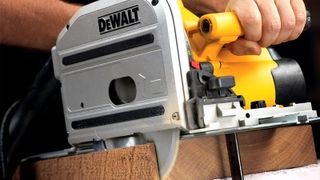What is a plunge saw and which DIY projects is it good for?
Want to know the answer to what is a plunge saw? Here we give you the lowdown on what it is, how it is used and how much they cost

What is a plunge saw? You might have heard the name and seen one in your local DIY store, but are not sure how it differs from other power saws? It's not an everyday general purpose power saw, it is a specialist saw that while similar to some other power saws it has a few subtle differences that make it a top tool for specific types of jobs.
There’s a lot of differenttypes of sawsfor DIYers, home renovators and self builders to choose, so where does a plunge saw fit in your collection? Here we tell you what a plunge saw is, reveal what jobs it’s good for and how much you should expect to pay for one to help you decide if it's the saw for you.
What is a plunge saw? A quick explanation
A plunge saw is a handheld power tool that has an enclosed circular blade (similar to a circular saw) and uses a plunging motion to create a cut. The plunging action can be set to a specific depth and the blade can be pushed down to start cutting. This action allows the saw blade to be placed anywhere on a piece of material i.e. wood, and cut a straight line from that point.
The blade enclosure means most of the dust is channelled into a dust extraction point which can be attached to a vacuum to help keep the area almost clean and dust-free.
It is also known as track saw as the design of a plunge saw allows the saw to be placed on a metal track. The track can be clamped down, which allows the blade to follow the track edge to create clean, accurate, straight cuts along the length of the track.
What is a plunge saw used for?
The action of a plunge saw means that it can be used to start a cut in the middle of material or from the edge like a circular saw. This makes it a great choice when working with worktops. It can quickly cut out the material to create a space for hobs or sinks. Plus, with a track it can create sharp straight cuts on worktop edges.
Its ability to repeatedly cut long straight edges makes it a good choice for cutting straight edges on sheets of wood, boards and planks including trimming decking edge in one go to get an even edge. It's also good for trimming wooden doors and thanks to its enclosed blade you can get close to the wall cuts of around 15mm-20mm making it a good choice for trimming already laid wooden floor edges.

How deep can a plunge saw cut?
Typically a plunge saw has a maximum cutting depth – on straight 90 degree cuts – of 50-80mm. The depth is determined by the size of the blade with 165mm blades being a common choice. The cutting depth will still differ from manufacturer to manufacturer, but the difference isn’t huge but worth checking out when looking to purchase a plunge saw.
A bigger 185mm blade will typically offer a larger cutting depth than a smaller blade. Expect to get at least an extra 10mm on cutting depth, but check the manufacturer's specifications to make sure.
How much does a plunge saw cost?
The prices for a plunge saw can vary greatly depending on brand, build, type and whether or not you are going to buy it with a track. At the low end of the price scale you can get a budget plunge saw like theSilverline DIY Tracksaw Kitfrom B&Q for just over £100. This is ideal for occasional use and a good starting point for DIY starters.
But if you are going to use a plunge saw on a regular basis, or want something better built you will be paying around £150-£300 for a mid range plunge saw like theScheppach PL55 Plunge Saw from Amazon. This comes with two 700mm guide rails, has a maximum cutting depth of 55mm and a dust extraction port.
At the top end of the range you can be paying anywhere from £600+ for a cordless plunge saw with batteries, a brushless heavy duty motor, deeper cutting depth and well-known brand name like theDewalt DCS520T2 XR FLEXVOLT Cordless Plunge Saw from Amazon. If you're going to get a lot of use out of a plunge saw it's worth making the investment, but for most DIYers and home renovators a mid rage model should be perfectly adequate for your projects.
What blades do plunge saws use?
Plunge saws use a circular blade with the number of teeth being the key to the type and quality of cut you get. Blades typically come with 24, 32, 42 and 48 teeth, typically the more teeth a blade has the finer the finish, but it takes longer to make the cut. For a quicker cut use a blade with less teeth. Check out ourSaw TPIguide for a more in depth look at saw blades.
Most blades have a bore size of 20mm. The bore is the hole in the middle of the blade, so make sure that you get a blade that is the right size for your plunge saw. Blades have different diameters commonly ranging from 160mm - 185mm, so again you need to make sure that you are getting the right size for your saw.
Get the Homebuilding & Renovating Newsletter
Bring your dream home to life with expert advice, how-to guides and design inspiration, direct to your inbox.
Steve is Homebuilding & Renovating's DIY content editor, and has been a writer and editor for two decades. He is an avid DIYer with over 20 years of experience in transforming and renovating homes. He specialises in painting and decorating, but has strong all-round building skills, having previously worked in the industry for 10 years.
Most Popular
Bring your dream home to life with expert advice, how-to guides and design inspiration, direct to your inbox.
Thank you for signing up to Homebuilding. You will receive a verification email shortly.
There was a problem. Please refresh the page and try again.

